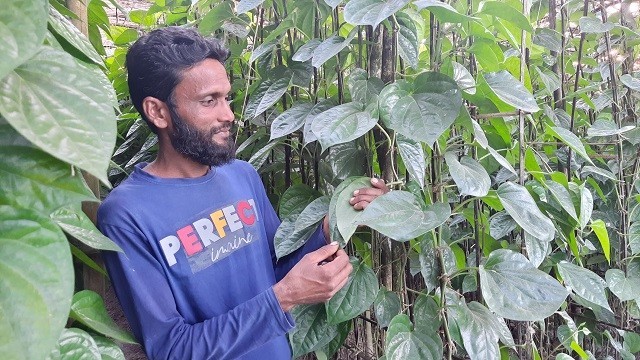Drink reigns in the city of mangoes
প্রকাশিত:
৩০ নভেম্বার ২০২৩, ২১:০০

"For me, Rajshahi is a place filled with history. My identity is deeply connected with Rajshahi. However, the Agriculture Department claims that the income from betel leaves in Rajshahi is twice the income from mangoes in a year. Betel leaves have become the main economic crop in this region. It not only sustains numerous families locally but also contributes to foreign exchange earnings by exporting to other countries. Farmers say that having betel leaves means having money in the bank. Unfortunately, there is not enough discussion and research on betel leaves like mine.
Agricultural and economic experts suggest that if managed properly during natural disasters, farmers can smile. However, when it comes to betel leaves in Rajshahi, there is not enough talk. There is no research center dedicated to betel leaves in this region. The Department of Industry has applied for approval from the Geographic Indicator (GI) for betel leaves at the Ministry of Industry. Last Wednesday (August 30th), the district administration completed all the processes of GI application from the Deputy Commissioner's office.
According to the Rajshahi Agriculture Extension Office, betel leaves are cultivated on 4,496 hectares of land in Rajshahi. The latest production of betel leaves in the last year was 76,678 metric tons. Bagmara in the district has the highest cultivation on 1,560 hectares, and Mohonpur is second with cultivation on 1,317 hectares.
It is reported that there are about 39,000 betel leaf farmers in the district. Additionally, approximately 40-45 thousand families are directly or indirectly involved in betel leaf-related jobs, including labor, business, and transportation. There are 20-25 major betel leaf markets in the district, with notable ones in Bagmara, Mohonpur, Daudkandi Bazar in Durgapur. However, Mohonpur has the highest number of betel leaf farmers, with 17,850 people.
In the field, betel leaf cultivation is surrounded by fences made of bamboo sticks within the vast fields of Mohonpur and Pabna. Farmers have planted various vegetables like rice, potatoes, bitter gourd, bottle gourd, etc., on the land used for betel leaf cultivation. To protect against wild animals, they have surrounded the area with blue-colored nets. In recent years, due to the decrease in wildlife attacks, many are now also cultivating betel leaves on lower lands. They have used special techniques, including planting betel vines on super structures and raising nets above betel plants to protect them from diseases.
Betel leaf farmers express that each betel vine is called a 'pili' in the local language, signifying a row of vines. They create a special type of bamboo clip called 'washi' to secure the betel vines in each pili. In the local language, they call this clip 'washi.' The tip of the bamboo, where the clip is attached, is called 'logoird.' The quantity of betel leaves produced is called 'pon,' with 80 logoirds making one pon. A betel leaf farmer typically cultivates betel leaves on 5 acres of land, requiring 20 laborers for each round of care.
To secure the betel vines with the washi, they use a special type of object made for this purpose, called 'willah.' They also use nets colored in blue to prevent disease and pests. They have planted adas and turmeric for protection. The adas and turmeric are raised above the betel leaves on bamboo sticks.
Betel leaf farmers emphasize that betel leaves are not just a crop but also a source of tranquility. They say that if betel leaves remain, there is peace, and if it dies, they also die.
It has been reported that the government has initiated efforts to establish a betel leaf research center in Mohonpur. A committee has been formed, and its members have visited two potential locations in Mohonpur about five to six months ago. The district is located 30 kilometers north of the district town. Considering this, betel leaf cultivators may open another door of possibilities. The Chairman of the Mohonpur Union Parishad, Md. Al-Amin Biswas, states that a betel leaf revolution is already happening here. About 70 percent of the population here cultivates betel leaves. Here, rice, potatoes, and betel leaves are grown extensively, especially betel leaves being the most valuable crop. Ada and turmeric are being introduced here this year. This can be beneficial for the betel leaf farmers as well.
Mustakima Khatoon, the Upazila Agriculture Officer of Mohonpur, says that betel leaves are not only economically significant but also possess medicinal properties. If a research center is established here, betel leaf cultivators can produce betel leaves safely. Moreover, it can contribute to foreign currency earnings.
In this regard, Mozaddar Hossain, the Deputy Director of the Rajshahi Agriculture Extension Office, mentions that profit is being made from betel leaves. However, there is a gap within betel leaf cultivation, and introducing ginger and turmeric in the shaded areas can fill that gap. This can bring about a change, and more people will be interested in betel leaf cultivation. Currently, Rajshahi's betel leaves are being exported to various countries."
bdgazzate/MAH



মন্তব্য করুন: